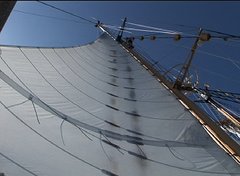 |
| The Seamansjust off Malden Island, from a Phantom drone |
The Stanford@SEA 2015 class has arrived at Malden Island
a relatively desolate coral island that is fringed by a reef. As we learned in our
maritime studies class from Professor Mary Malloy the European discovery was by
Captain Lord Byron on the HMS Blond on the 29th of July in 1825 and one wonders
what the crew and the Captain saw. The reef here now is in unusually poor
condition with much dead coral and small areas with 35% coral cover. I saw one
spur with 100% but it was a rare find.
In the mid 50s and early 60s this island was used for nuclear testing by
the UK and USA and while it is now on shore a protected wildlife sanctuary on
shore under the Kiribati government it is clear something is amiss. The reef
was throughout most of the shallow areas impacted greatly-with poor coral
cover- virtually a dead reef- but in deeper portions of the spurs it came alive
again. Although fish diversity in some
areas was high- the overall impression is a place either impacted by the
environmental factors of equatorial environment or large waves, or potentially
damaged by mankind. Maybe nuclear testing left an impact we just don't know.
 While our first approach suggested it was not
very sharky- a mystery is evident here too. We have sighted many larger grey
reef sharks and some healthy white tips- perhaps year class 3 or so- they seem thin compared to the plump
sharks we saw down at Caroline atoll. Surprisingly there are few pups in the
areas we've visited thus far- one year olds are missing of the Grey reef year
class thus far (note we may find them all tomorrow) and very few white tips or
black tips. The Lagoon is inaccessible so perhaps nursery areas are not
prevalent and the Grey reefs dominate. So overall its just one year class of
grey reef shark all in the 5-6 ft class.
While our first approach suggested it was not
very sharky- a mystery is evident here too. We have sighted many larger grey
reef sharks and some healthy white tips- perhaps year class 3 or so- they seem thin compared to the plump
sharks we saw down at Caroline atoll. Surprisingly there are few pups in the
areas we've visited thus far- one year olds are missing of the Grey reef year
class thus far (note we may find them all tomorrow) and very few white tips or
black tips. The Lagoon is inaccessible so perhaps nursery areas are not
prevalent and the Grey reefs dominate. So overall its just one year class of
grey reef shark all in the 5-6 ft class.
So
in this uninhabited place we see a reef in decline- and odd year classes
of sharks, turf covered reef and surgeon fish abounding. I will say the parrot
fish and snappers, while often few in numbers, are among the largest we've seen
but live coral cover is limited to small regions of the reef. We'll continue exploring today- and hopefully
find a region of Malden that is a bit more lively- project time has been ample for our snorkeling
teams and both the fish biomass team and coral teams have been obtaining new
transects.
Hypotheses are numerous about what has occurred in this
location and will surely be a point of discussion in the next few days. The heat of the equatorial sun can be felt by
all and efforts to remain covered up in this hot climate abound.
We once again flew the Phantom drone across the landscape
and have some beautiful pictures from above to share with all of you from
Malden- winds are light-and seas are warm!
Barbara Block


1 comment:
That's too bad about the state of the reef. I imagine this came as a shock after the healthy and pristine reefs you've encountered so far. Can't imagine the nuclear testing helped much. Must be wonderful for the students to be able to swim with so many sharks and other marine creatures!
Post a Comment